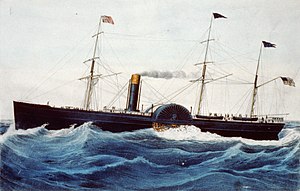 Baltic
| |
| History | |
|---|---|
| Name | Baltic |
| Namesake | Baltic Sea |
| Operator | Collins Line |
| Route | New York-Liverpool |
| Builder | Brown & Bell, New York |
| Cost | ~$750,000[1] |
| Launched | 5 Feb 1850 |
| Maiden voyage | 16 Nov 1850 |
| In service | 16 Nov 1850 |
| Out of service | 1880 |
| Refit | As a sailing ship, 1870 |
| Honors and awards | Blue Riband holder, 16 Aug 1851–29 Apr 1856 |
| Fate | Scrapped, 1880 |
| General characteristics | |
| Type | Passenger |
| Tonnage | 2,723 gross tons |
| Length | 282 ft (86 m) |
| Beam | 45 ft (14 m) |
| Depth of hold | 24 ft |
| Propulsion | 2 × 500 hp, 96-inch bore, 10-foot stroke single-cylinder side-lever steam engines |
| Speed | 13 knots |
| Capacity | Passengers: 200 1st class, 80 2nd class |
SS Baltic was a wooden-hulled sidewheel steamer built in 1850 for transatlantic service with the American Collins Line. Designed to outclass their chief rivals from the British-owned Cunard Line, Baltic and her three sister ships—Atlantic, Pacific and Arctic—were the largest, fastest and most luxurious transatlantic steamships of their day.
Less than a year after entering service, Baltic captured the coveted Blue Riband in 1851 for fastest transatlantic crossing by a steamship. She set a new record again in 1854, and was to remain the fastest steamship on the Atlantic for almost five years. In spite of these record-breaking achievements however, her Collins Line owners continued to lose money, and were eventually bankrupted in 1858.
Baltic subsequently operated as a coastal steamer along the East Coast of the United States, and later served as a transport for the Union cause during the American Civil War before briefly returning to transatlantic service. In her final years she was converted into a sailing ship. Baltic was scrapped in 1880.
- ^ Combined cost of the four Collins steamers was $2,944,000. (Morrison, p. 412). Since the first two ships cost about $700,000, it is assumed the second two, including Baltic, cost about $750,000 each.